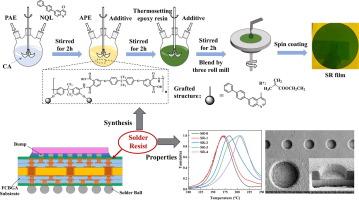使用碱溶性光敏聚酰亚胺制备高 Tg 和低 CTE 阻焊层的策略
IF 5.8
2区 化学
Q1 POLYMER SCIENCE
引用次数: 0
摘要
光敏阻焊(SR)材料需要较高的玻璃化转变温度(Tg > 170 °C)和与铜相匹配的热膨胀系数(CTE≈17 ppm/°C),以满足制造工艺和应用可靠性的要求。然而,SR 材料中常用的环氧树脂显示出的机械和热性能不足,无法充分满足这些要求。为了解决这个问题,我们合成了碱溶性光敏聚(氨基酯)(PAE)材料。通过在 PAE 的羟基上接枝低温固化促进剂 6-([1,1′-联苯]-4-基)-4-氯喹啉 (NQL),将接枝的 PAE 树脂与碱溶性光敏改性环氧树脂 (APE) 混合,以提高 SR 复合材料的机械和热性能。研究表明,由于 NQL 的低温固化效应和静电相互作用,SR-2(PAE 添加量为 10%)的 Tg 为 183°C,CTE 为 16 ppm/°C,而 SR-3(PAE 添加量为 30%)的 Tg 为 204°C,CTE 为 20 ppm/°C。此外,当 PAE 添加量为 5%时,SR 的光刻质量得到提高,使 SR-1 的图案分辨率高达 40 μm。掺入 PSPI 的改性方法提高了 SR 的热稳定性、尺寸稳定性和光刻性能,表明其在阻焊材料中的应用潜力巨大。本文章由计算机程序翻译,如有差异,请以英文原文为准。

A strategy to prepare high Tg and low CTE solder resist using alkali-soluble photosensitive polyimide
Photosensitive Solder resist (SR) materials require a high glass transition temperature (Tg > 170 °C) and a coefficient of thermal expansion matching that of copper (CTE≈17 ppm/°C) to meet the demands of manufacturing processes and application reliability. However, the commonly used epoxy resin in SR materials exhibits insufficient mechanical and thermal properties, failing to meet these requirements adequately. To address this issue, alkali-soluble photosensitive poly (amic ester) (PAE) materials were synthesized. By grafting a low-temperature curing accelerator, 6-([1,1′-biphenyl]–4-yl)–4-chloroquinoline (NQL), onto the hydroxyl groups of the PAE, the resultant grafted PAE resin was blended with an alkali-soluble photosensitive modified epoxy resin (APE) to enhance the mechanical and thermal properties of the SR composite. Research indicates that due to the low-temperature curing effect and electrostatic interactions of NQL, SR-2 (with a 10% PAE addition) exhibits a Tg of 183 °C and a CTE of 16 ppm/°C, while SR-3 (with a 30% PAE addition) achieves a Tg of 204 °C and a CTE of 20 ppm/°C. Furthermore, with the PAE addition of 5%, the lithography quality of SR is enhanced, enabling SR-1 to achieve a pattern resolution of up to 40 μm. The modification method involving PSPI blending has been shown to enhance the thermal stability, dimensional stability, and lithographic performance of SR, indicating significant potential applications in solder resist materials.
求助全文
通过发布文献求助,成功后即可免费获取论文全文。
去求助
来源期刊

European Polymer Journal
化学-高分子科学
CiteScore
9.90
自引率
10.00%
发文量
691
审稿时长
23 days
期刊介绍:
European Polymer Journal is dedicated to publishing work on fundamental and applied polymer chemistry and macromolecular materials. The journal covers all aspects of polymer synthesis, including polymerization mechanisms and chemical functional transformations, with a focus on novel polymers and the relationships between molecular structure and polymer properties. In addition, we welcome submissions on bio-based or renewable polymers, stimuli-responsive systems and polymer bio-hybrids. European Polymer Journal also publishes research on the biomedical application of polymers, including drug delivery and regenerative medicine. The main scope is covered but not limited to the following core research areas:
Polymer synthesis and functionalization
• Novel synthetic routes for polymerization, functional modification, controlled/living polymerization and precision polymers.
Stimuli-responsive polymers
• Including shape memory and self-healing polymers.
Supramolecular polymers and self-assembly
• Molecular recognition and higher order polymer structures.
Renewable and sustainable polymers
• Bio-based, biodegradable and anti-microbial polymers and polymeric bio-nanocomposites.
Polymers at interfaces and surfaces
• Chemistry and engineering of surfaces with biological relevance, including patterning, antifouling polymers and polymers for membrane applications.
Biomedical applications and nanomedicine
• Polymers for regenerative medicine, drug delivery molecular release and gene therapy
The scope of European Polymer Journal no longer includes Polymer Physics.
 求助内容:
求助内容: 应助结果提醒方式:
应助结果提醒方式:


